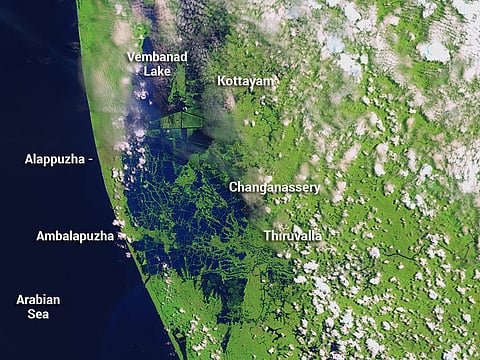Look: Kerala from space, before and after the floods
Nasa shared satellite images of Kerala before and after the flood

Dubai: Kerala’s topography has been severely impacted by the floods.
The Nasa (National Aeronautics and Space Administration) has released satellite images that show the extent of inundation by flood waters.
#Keralafloods have killed over 400 and rendered hundreds of thousands homeless.
Yesterday, Nasa published an interactive graphic on their website with two images. One taken on February 6, 2018, before the floods and the other taken on August 22, 2018 after the floods.
According to Nasa’s website: “... the European Space Agency’s Sentinel-2 satellite acquired the right image on August 22, 2018, after flood water had inundated the area. The images … makes flood water appear dark blue. Vegetation is bright green.”
Take a look at the interactive image below to compare the apparent difference in the topography after the flooding – clearly showing how wide the coverage by dark blue has become.
Credit: Nasa
The report also highlights that “several rivers throughout the region spilled over their banks. Water from the Karuvannur River ran through 40 villages, and washed away a 2.2km stretch of land connecting two national highways. Elevated water levels along the Periyar River displaced thousands of people.”
Last week, the space agency also shared a video on YouTube analysing the rainfall in Kerala, which caused the flooding. It was quite shocking.
Tweep @vaibhavBhatna14 shared the video on Twitter: “Just what kind of rain was it that caused the unprecedented floods in #Kerala? To provide an idea, @NASA has released the data retrieved from Global Precipitation Measurement (GPM) satellites in the period between August 13 and August 20. #KeralaFloods”
According to the Indian Meteorological Department, Kerala received 771mm rainfall between August 1-20. This is the highest since 1931 when the southern state received 1132.9mm of rainfall in the entire four-month-long monsoon season – 175 per cent more than normal.
Compared to this, in 2018, between August 16-22 Kerala received 219 per cent more than normal rainfall.
Nasa, in an earlier report had also stated: "Abnormally heavy monsoon rains drenched Southeast Asia, leading to the worst flooding in the state of Kerala since 1924. The event, which started with rains on August 8, 2018, displaced over a million people, led to hundreds of deaths, damaged over 50,000 houses throughout the region, and severely affected 13 of the 14 districts in Kerala... Rainfall peaked in Kerala on July 20 and again reached abnormally high levels between August 8 and 16. Since the beginning of June, the region received 42 per cent more rainfall than normal for this time period. In the first 20 days of August, the region experienced 164 per cent more rain than normal.
"Kerala's August rain played a part in the nearly once-in-a-century flooding, although the flooding was worsened when water was released from several full dams. Instead of gradually releasing water during drier times, authorities were forced to open 80 dams in the region, including the Idukki Dam, which is one of the largest arch dams in Asia. Thirty-five of those dams were opened for the first time."
The space agency's official website also quoted Sujay Kumar, research scientist at NASA's Goddard Space Flight Center: "The dam releases came way too late, and it coincided with the heavy rain that was occurring."
However, as per a previous Gulf News report, Kerala State Electricity Board (KSEB) chairman, N.S. Pillai, denied this claim, which has also been made by the political Opposition in the state, and said: “If we had opened the dam gates at a much lower water level, we would have been blamed in the months ahead, saying all the water was used up. The fact is that we managed the dams well. We should in fact be congratulated for the manner in which we conducted the dam management."
Sign up for the Daily Briefing
Get the latest news and updates straight to your inbox



